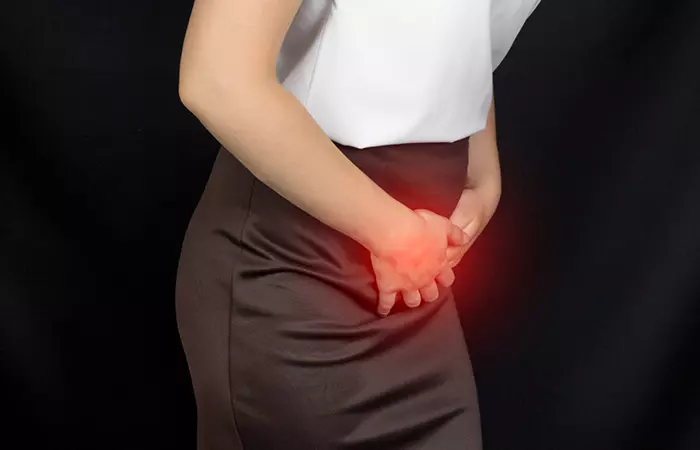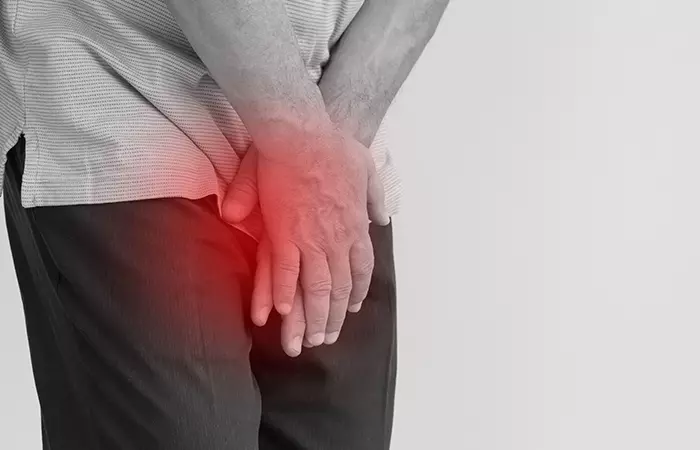What Is A Sitz Bath?
Individuals experiencing swelling, itching, or pain in the perineal region (comprising the vulva, anus, and urethra) are often suggested by doctors to bathe it in a tub filled with soothing warm water – called the sitz bath. Pour some warm water up to a few inches, ensure the temperature is comfortable, and dip your lower body into it up to your pelvis. Practice this at least 3 times a day, or more, as per your doctor’s advice. Your doctor might also prescribe an oil or a medicine to be added to the water.
Let us now look at how a sitz bath works to heal pain.
How Does A Sitz Bath Work?
When you soak your pelvis in warm water, the heat allows your muscles, especially the sphincter, to relax. It also increases blood circulation to the perineal region and eases pain. This promotes healing and reduces the pain, itching, and irritation felt due to various health conditions. Doctors often prescribe medicines to add to the warm water. These help treat infections by fighting the pathogenic bacteria. Let us now find out some of the health benefits of taking a sitz bath.
Health Benefits Of Sitz Baths
1. Make Vaginal Delivery Smoother
The vulva remains sore and swollen for quite some time after a vaginal delivery. Opting for a sitz bath for postpartum recovery can provide comfort and much-needed relief from soreness. Dipping the pelvis in warm water for some time not only helps clean the perineumi The area between the inner thighs that starts from the urethra and ends at the anus, comprising the vagina in females and penis in males. but also relaxes the stiff muscles and relieves pain to a large extent. Studies suggest that warm sitz baths help improve blood circulation in the anal tissue and also reduce pain by minimizing the tone of the internal anal sphincteri A muscle found in the anal canal that dilates to let the stool pass through it and closes after it’s passed. (a ring of smooth muscle that surrounds the anal canal) (1). In addition, anecdotal evidence states that a sitz bath may relieve discomfort in the genital area and help reduce healing time after labor.
2. May Help With Bartholin’s Cyst
The Bartholin’s glands are positioned on either side of the vaginal opening and are responsible for secreting fluids for lubricating the vaginal walls. Sometimes, due to injuries or infections, the openings of these glands may get blocked, trapping the fluids inside. This may cause cystic swellings that are called Bartholin’s cysts (2). While smaller cysts may not be noticeable, if left untreated, they may grow bigger and cause discomfort and pain. A sitz bath a few times a day for 3-4 days may cause the cysts to rupture and drain away by themselves.
3. May Ease Hemorrhoids
Having a sitz bath during hemorrhoids can help relieve the swelling of the veins in the anus and lower rectum. This makes bowel movement easier and pain-free. Anecdotal evidence also suggests that sitz baths may also soothe hemorrhoids that occur in some pregnant women after childbirth. Soaking the affected area in warm salt water several times a day, for about 10–15 minutes each time, helps promote comfort. Thus, it is a great home remedy for hemorrhoids. Besides sitz baths, there are more home remedies for hemorrhoids that you can try, such as aloe vera, tea tree oil, and witch hazel. All you need to know is the right way to use them. In addition, sitz baths even help manage postoperative pain (3).
4. May Prevent Infections
You may consult a physician and add some antiseptic ointment to your sitz bath to thoroughly clean the perineum and treat the infection. Sitz baths, with or without pharmacological therapies, may help prevent infections. A study published in the Journal of Family and Reproductive Health states how a sitz bath containing an extract of myrrh plant helps improve wound healing and reduces infections (3).
5. May Help Treat Prostatitis
Sitz baths help relax the prostate’s smooth muscle, relieve the tightness of the urethra and bladder neck, and boost blood flow to the pelvic area. Studies suggest that these baths can help improve the symptoms of chronic bacterial prostatitis (5). The water used in such sitz baths can be either hot or lukewarm.
6. May Reduce Anal Fissures
Muscle spasms are a primary cause of pain in conditions like anal fissures. Sitz baths can relax these muscles and relieve pain while slowly healing the fissures (6). In addition, the analgesic properties of sitz baths help treat anal fissures (7). However, besides sitz baths, there are more ways to treat anal fissures, such as coconut oil, honey, olive oil, etc. All you need to know is the right way of using these remedies. These are the ways sitz baths can help relieve your pain. While these are generally harmless, it is important to be aware of their potential risks too. Check out the next section.
Potential Risk Factors
Since sitz baths are noninvasive treatments, there is little chance of injury. An infection of the perineum is the most frequent negative side effect related to sitz baths. However, this can only occur if you neglect to thoroughly clean the tub or plastic bath and use it when you have a surgical wound. Also, never let anyone else use your sitz bath as that can be unhygienic. Stop taking the sitz bath and consult a doctor if your perineum turns red and puffy or the pain or itching worsens. Should the bath make you feel better, your doctor may advise taking it three to four times a day until the itch, irritation, or pain is relieved.
How To Do A Sitz Bath
1. Sitz Bath At Home
2. Sitz Bath With Baking Soda
Baking soda can be added to the sitz bath tub to fight infections. The acidic pH of urine can be neutralized by baking soda. It also helps treat painful urination.
3. Sitz Bath For Toilet
Sitz bath kits are also available on the market as a small portable apparatus that can be easily placed on any toilet seat. The kit comes with a pump that allows you to fill the toilet with water. You can place it on the toilet and easily dip your hip region into the shallow pool created.
When To Call A Doctor
Call your doctor right away if you experience any pain or bleeding in your anal region. These could indicate hemorrhoids or some other ailment. Also, consult with a doctor if any perineal soreness or abnormal discharge persists even after a few sitz baths. They may help diagnose the root cause. How long should you take a sitz bath? You can take a sitz bath for 10 to 20 minutes. Can I use normal salt for a sitz bath? Yes, you may use normal salt in a sitz bath. But consult your doctor prior. Should a sitz bath be hot or cold? A sitz bath should be hot or lukewarm so that it is comforting to your skin. Should you add anything to a sitz bath? You can add epsom salt or essential oils to the sitz basin. If epsom salt is not available, consider adding normal salt. How does a sitz bath shrink hemorrhoids fast? The heat from the water in the sitz bath reaches the perineum, spreads across the anal region, and relaxes the anal sphincter. This regulates the blood flow to this region, relieves pain, and shrinks the hemorrhoids (8).
Illustration: Sitz Bath: Benefits Risk Factors And How To Do It Properly
A sitz bath is a great way to ease pain and discomfort. Watch this informative video to learn about its several benefits for your body.














